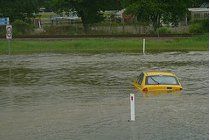Floods improving Australia’s climate strategy
The devastating floods in the state of Queensland, Australia are pushing along a new national strategy to adapt to global warming.

 The devastating floods in the state of Queensland, Australia are pushing along a new national strategy to adapt to global warming.
The devastating floods in the state of Queensland, Australia are pushing along a new national strategy to adapt to global warming.
Australia has long been susceptible to droughts and flooding rains, and the country has built up a high resiliency to weather crises.
Record rainfalls in the northeast, coming after a long drought in the south, are pushing the nation to take further action. Australia is fast becoming a leader in planning for adaptation to rapid climate change.
The devastating floods in the state of Queensland have left an inland sea the size of Germany and France, and the 30-foot rise of three rivers has affected approximately 200,000 people as well as vital coal exports.
Even though the weather crisis in Queensland is attributed more to the wet and dry cycles of the La Niña and El Niño changes in the Pacific, it is influencing Australia's national strategy to adapt to climate change. Officials have put army general, Mick Slater, in charge of recovery from the disaster.
A year ago, a government paper set out an adaptation strategy, stating: "Already Australia faces a stark fact – the opportunity to avoid climate change altogether has passed."
The government recognises the political reality that the world's major polluters, including Australia, are not moving fast enough to reduce greenhouse gases (GHG) in order to slow down an expected rise in atmospheric temperatures.
The statement, and subsequent movement by the Australian Government following the recent weather crisis, shows promise that climate shocks will no longer be played down. The effects of factors other than CO2 emissions on climate change are being recognised.
The government has laid out various plans to help farmers adjust to the official prediction that climate change will cut food production by more than 15 per cent.
The largest spending on adaptation thus far is a 10 year, $12.9 billion program, called "Water for the Future -- part of the 2008 Federal Budget announced by the Australian Government. It includes setting up a robust market for water resources so that as water becomes more scarce there are incentives to deliver it to the areas of highest priority.
The government also plans to issue a "climate futures report" every five years, beginning this year. In 2010, it sponsored the world's first official conference on climate change adaptation and set up a dedicated research facility. One study hopes to create a model for resilience by looking at four communities that bounced back from natural disasters.
Australia is being forced to adapt more quickly to climate change, and it is hoped that action will influence other organisations and nations, helping future generations.
Author: Marianna Keen | Climate Action
Image: MasterMan | Flickr






